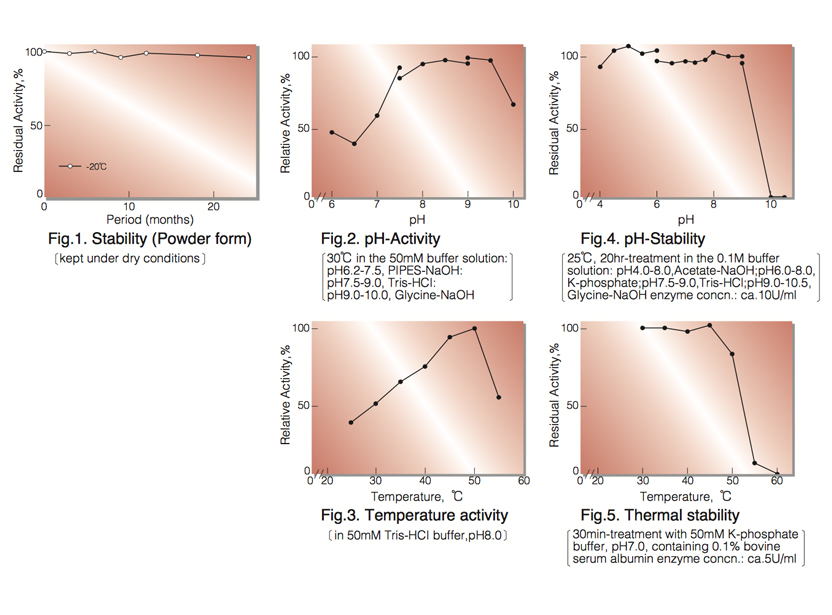HEXOKINASE from Microorganism
HXK-311
| Appearance: | White amorphous powder, lyophilized | ||
|---|---|---|---|
| Activity: | GradeⅢ 150U/mg-solid or more |
||
| Contaminants: | Phosphoglucose isomerase ≤1.0×10⁻¹% 6-Phosphogluconate dehydrogenase ≤1.0×10⁻²% Glucose-6-phosphate dehydrogenase ≤1.0×10⁻²% Myokinase ≤1.0×10⁻²% Glutathione reductase ≤ 5.0×10⁻¹% |
||
| Stability: | Stable at -20°C for at least One year (Fig.1) |
|---|---|
| Molecular weight : | approx. 82,000 (by gel filtration) |
| Isoelectric point : | 4.1±0.1 |
| Michaelis constants : | 2.3×10⁻⁴M (D-Glucose), 7.7×10⁻⁵M (ATP) |
| Inhibitors : | Metal ions, p-chloromercuribenzoate, iodoacetamide, SDS, etc |
| Optimum pH : | 8.0-9.0(Fig.2) |
| Optimum temperature : | 50°C(Fig.3) |
| pH Stability : | pH 4.0-9.0 (25°C, 20hr)(Fig.4) |
| Thermal stability : | below 45°C (pH 7.0, 30min)(Fig.5) |
| Substrate specificity : | (Table 1) |
| Effect of various chemicals: | (Table 2) |
APPLICATIONS
The enzyme is useful for enzymatic determination of glucose, adenosine-5'-triphosphate (ATP) and creatine phosphokinase when coupled with glucose-6-phosphate dehydrogenase (=G-6-PDH, G6D- 311, G6D-321).
ASSAY
Principle:
hexokinase
D-Glucose+ATP ► D-Glucose-6-phosphate+ADP
G-6-PDH
D-Glucose-6-phosphate+NAD⁺ ► Glucono-δ-lactone-6-phosphate+NADH+H⁺
The appearance of NADH is measured at 340nm by spectrophotometry.
Unit definition:
One unit causes the formation of one micromole of NADH per minute under the conditions described below.
Method:
| A. Tris-HCl buffer, pH 8.0: | 50mM, containing 13.3mM MgCl₂ |
|---|---|
| B. Glucose solution: | 0.67M in Tris-HCI buffer solution (A) (The solution Should be keep at room temperature at least for 1 hour before use) |
| C. ATP solution: | 16.5mM in Tris-HCl buffer solution (A) (Should be prepared fresh) |
| D. NAD⁺ solution: | 6.8mM in Tris-HCl buffer solution (A) (Should be prepared fresh) |
| E. G-6-PDH solution: | 300U/ml (Dilute with Tris-HCl buffer solution (A) and store on ice) |
| F. Enzyme diluent: | Tris-HCl buffer solution (A) contg. 0.1% of bovine serum albumin |
Procedure
| Concentration in assay mixture | |
|---|---|
| Tris-HCl buffer | 50 mM |
| Glucose | 0.11 M |
| ATP | 0.53 mM |
| NAD⁺ |
0.22 mM |
| MgCl₂ | 13 mM |
| BSA | 3.2µg/ml |
| G-6-PDH | ca.1.0 U/ml |
1. Prepare the following reactin mixture in a cuvette (d=1.0cm) and equilibrate at 30°C for about 5 minutes.
2.30 ml Tris-HCl buffer solution (A)
0.50 ml Glucose solution (B)
0.10 ml ATP solution (C)
0.10 ml NAD⁺ solution (D)
0.01 ml G-6-PDH solution (E)
2. Add 0.1ml of the enzyme solution* and mix by gentle inversion.
3. Record the increase of optical density at 340nm against water for 4 to 5 minutes in a spectrophotometer thermostated at 30°C and calculate theΔOD per minute from the initial portion of the curve (ΔOD test).
At the same time, measure the blank rate (ΔOD blank) by the same method as the test except the enzyme
diluent (F) is added instead of the enzyme solution.
* Dissolve the enzyme preparation on ice-cold enzyme diluent (F) and dilute to 0.1-0.3U/ml with the same buffer, immediately before assay.
Calculation
Activity can be calculated by using the following formula :

ΔOD/min (OD test−OD blank ) ×Vt × df
Volume activity (U/ml) = =ΔOD/min×5.0×df
6.22×1.0×Vs
Weight activity (U/mg)=(U/ml)×1/C
- Vt
- : Total volume (3.11ml)
- Vs
- : Sample volume (0.1ml)
- 1.0
- : Light path length (cm)
- 6.22
- : Millimolar extinction coefficient of NADH (㎠/micromole)
- df
- : Dilution factor
- C
- : Enzyme concentration in dissolution (c mg/ml)
| Substrate(100mM) | Relative activity(%) | Substrate(100mM) | Relative activity(%) |
|---|---|---|---|
| D-Glucose | 100 | D-Galactose | 0 |
| D-Fructose | 140 | D-Xylose | 2 |
| D-Mannose | 52 | D-Glucosamine | 58 |
| 2-Deoxy-D-glucose | 91 |
| Chemical | Concn.(mM) | Residual activity(%) |
Chemical | Concn.(mM) | Residual activity(%) |
|---|---|---|---|---|---|
| None | − | 100 | PCMB | 2.0 | 0 |
| Metal salt | MIA | 2.0 | 80 | ||
| AgNO₃ | 2.0 | 0 |
IAA | 2.0 | 7 |
| BaCl₂ |
2.0 | 99 | EDTA | 5.0 | 103 |
| CaCl₂ | 2.0 | 98 | (NH₄)₂SO₄ | 20.0 | 104 |
| CdCl₂ | 2.0 | 85 | Borate | 20.0 | 102 |
| CoCl₂ | 2.0 | 85 | o-Phenanthroline | 2.0 | 101 |
| CuSO₄ | 2.0 | 25 | α,α′-Dipyridyl | 2.0 | 102 |
| FeCl₃ | 2.0 | 28 | Urea | 2.0 | 104 |
| FeSO₄ | 2.0 | 80 | Guanidine | 2.0 | 103 |
| HgCl₂ | 2.0 | 0 | Hydroxylamine | 2.0 | 104 |
| MgCl₂ | 2.0 | 98 | Na-cholate | 1.0% | 102 |
| MnCl₂ | 2.0 | 100 | Triton X-100 | 1.0% | 105 |
| NiCl₂ | 2.0 | 100 | Brij 35 | 1.0% | 0 |
| Pb(OAc)₂ | 2.0 | 98 | SDS | 0.1% | 25 |
| Zn(OAc)₂ | 2.0 | 98 | Tween 20 | 0.1% | 101 |
| ZnSO₄ | 2.0 | 99 | Span 20 | 0.1% | 106 |
| NaF | 20.0 | 101 | DAC | 0.1% | 101 |
| NaN₃ | 20.0 | 102 |
Ac, CH₃CO; NEM, N-Ethylmaleimide; PCMB, p-Chloromercuribenzoate; MIA, Monoiodoacetate; EDTA, Ethylenediaminetetraacetate; IAA, Iodoacetamide; SDS, Sodium dodecyl sulfate; DAC, Dimethylbenzylalkylammonium chloride.

To get a quote, contact us at info@toyobousa.com, or INQUIRY.
